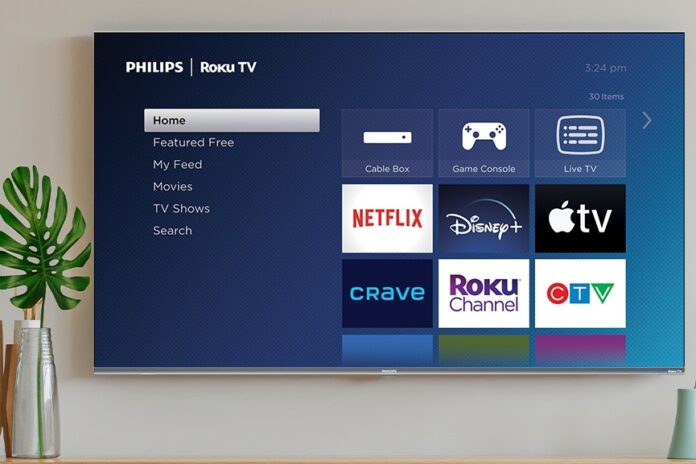The very recent Philips TV equipped with the Roku system does not have the most dazzling technical specifications and, curiously, does not have a Bluetooth connection. But offering a 4K QLED display and some features reserved for more expensive TVs starting at $550 is impressive. Difficult to find better for this budget.
Since 2014, digital player maker Roku has partnered with half a dozen manufacturers, including Hisense, TCL, and RCA, to offer its “Roku TVs.” They of course use the friendly Roku platform, in large, clearly visible tiles offering thousands of internet channels, integrated into decently equipped televisions at a very reasonable price.
The all-new Philips Roku, whose 55-inch model we tried for $649.99, takes up the torch. This 4K UHD television incorporates a technology popularized by Samsung, the QLED, presented as an improvement on the classic two-panel system. A third layer of “quantum dots” is inserted, the backlight is blue rather than yellow, which improves the contrast, colors and brilliance of the image.
So what does the picture look like? In summary, it is slightly better, richer and more contrasted than on a conventional 4K LED TV. However, we are very far from the sharpness and infinite contrast of OLED televisions, which are three times more expensive. The exercise is complicated because of the many possible settings. In cinematic mode, we found the image to be fluid and the colors to be realistic. In Game Mode, however, the colors tended to be so saturated that we dropped this setting.
More sober programs such as those offered by Radio-Canada or TVA were well rendered, with a well-cut image and well-adjusted colors. The sound offered by the two 10-watt speakers is honest, slightly above average with a noticeably enriched bass.
Here we have a 3840 by 2160 pixel screen, which is called “Ultra HD 4K” on the market, with a refresh rate of 60 Hz. The contrast ratio of 5000: 1 is worthy of high-end televisions, with a standard viewing angle of 178 degrees.
The configuration for any user already registered with Roku is a charm, while all the channels to which one is subscribed are reinstalled automatically. The new user must go through the creation of an account, which is done in about ten minutes. We then have access to what has made Roku the number one manufacturer in North America of digital players, in HDMI key or box: the approximately 5,000 internet channels. To the classics Netflix, Disney and Spotify have all recently been added. tv EXTRA, a guide to live channels and in-house content from the Roku Channel.
The most interesting content remains the one for which you have to pay, but thousands of free channels, of very uneven quality, are available.
In terms of clarity, hard to beat that of the Roku interface. No fuss here, intrusive promotions or menus that you can’t erase: your favorite channels appear in large tiles well organized in three columns according to your tastes.
For connections, the Philips Roku offers four HDMI inputs, an AV composite video input, an optical digital audio output, a stereo audio output and a 3.5mm headphone jack. A USB port also allows you to connect a key to access content. You can finally control the TV directly from your phone with the Roku app. The TV accepts AirPlay and Google Cast connections, and you can install voice assistants from Google and Amazon.
For a user who prefers the use of Bluetooth headsets, the Philips Roku is not recommended. Impossible to connect our wireless headphones directly, you have to go through a Bluetooth connection in the Roku app on the phone. And it does not accept certain inputs, including video game consoles.
A feature called “Perfect Motion Rate 120” simulates, very imperfectly in our opinion, a higher frame rate.
The rendering of darker images, when the action takes place at night, leaves something to be desired, with touches of gray. This gray also appears in certain menus, notably Apple TV and that of the Nintendo Switch.
Some models that appear on the market give a good indication of its evolution, and the Philips Roku definitely marks a downward trend in prices for technical specifications that were once more expensive. It would have been unlikely two years ago to find such a device for $650. So here we have a television much better equipped than the average, at a price approaching the entry level. It won’t satisfy the most demanding viewers or video gamers, but is a recommendable purchase for most users.
It’s hard to comment on the durability of this very recent model, but the Roku products we’ve been testing since 2016 are reassuring in this regard.















